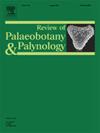Epidermal anatomy of Pterophyllum ptilum (Cycadophyta: Bennettitales) from the Upper Triassic of Sichuan Province, Southwest China
IF 1.7
3区 地球科学
Q2 PALEONTOLOGY
引用次数: 0
Abstract
Pterophyllum ptilum Harris 1932 is a distinctive fossil plant species that occurred exclusively in the Late Triassic but in a broad geographic distribution ranging from North Europe to East Asia. Thus, this species has long been considered significant in stratigraphic correlation of non-marine sequences. However, previous studies of P. ptilum have been mostly focused on the morphological characteristics of its foliages, a complete biological feature, particularly the epidermal anatomy, remains poorly understood. Here, we show detailed epidermal anatomies of P. ptilum based on well-preserved cuticular specimens from the Upper Triassic of Sichuan Province, Southwest China. Pterophyllum ptilum is characterised by petiolate leaves with small lateral leaflets, which possess contracted bases and bicuspid apices with five to eight parallel veins and syndetocheilic type stomata. In the leaflets, the stomata are only present on the abaxial surface, whereas the stomata are present on both the abaxial and adaxial surfaces of the rachis. Both the adaxial and abaxial leaflet surfaces can be divided into costal and intercostal fields. The epidermal cells in the costal fields are elongated rectangular but shortened rectangular in the intercostal fields. The stomata are only present in the intercostal fields of the abaxial leaflet surface. On the rachis, the epidermal cells are all elongated rectangular and arranged tightly in vertical files. Based on a thorough comparison of fossil records and observation of extant cycads, we propose that the bicuspid leaflet apices of P. ptilum may resulted from herbivorous arthropod apical feeding damage. Fossil records reveal that P. ptilum were primarily preserved in coastal plain, deltaic, and tidal flat environments in the South China Block; the absence of papillae and hairs in the present specimens may suggest a relatively more humid local environment.
中国西南部四川省上三叠统 Pterophyllum ptilum(苏铁纲:Bennettitales)的表皮解剖图
Pterophyllum ptilum Harris 1932是一种独特的植物化石,仅出现在晚三叠世,但在从北欧到东亚的广泛地理分布。因此,该物种在非海相层序地层对比中一直被认为具有重要意义。然而,以往的研究大多集中在其叶片的形态特征上,对其完整的生物学特征,特别是表皮解剖结构知之甚少。本文以四川上三叠统保存完好的ptilum表皮标本为研究对象,对其表皮结构进行了详细的解剖。Pterophyllum ptilum的特点是有柄的叶子和小横向传单,具有简约基地和僧帽顶端五到八个平行脉和syndetocheilic气孔类型。在小叶中,气孔只存在于背面,而在轴的背面和正面都有气孔。小叶的正面和背面表面可分为肋区和肋间区。肋野表皮细胞呈细长矩形,肋野间表皮细胞呈短矩形。气孔只存在于小叶背面的肋间区。轴部表皮细胞呈长条形,排列紧密,呈纵列。通过对现存苏铁化石记录的比较和对现存苏铁的观察,我们认为苏铁叶尖的双尖可能是草食性节肢动物对叶尖的摄食造成的。化石记录显示,草木属主要保存在华南地块的沿海平原、三角洲和潮滩环境中;目前标本中乳头和毛发的缺失可能表明当地环境相对较潮湿。
本文章由计算机程序翻译,如有差异,请以英文原文为准。
求助全文
约1分钟内获得全文
求助全文
来源期刊
CiteScore
3.50
自引率
21.10%
发文量
149
审稿时长
6 months
期刊介绍:
The Review of Palaeobotany and Palynology is an international journal for articles in all fields of palaeobotany and palynology dealing with all groups, ranging from marine palynomorphs to higher land plants. Original contributions and comprehensive review papers should appeal to an international audience. Typical topics include but are not restricted to systematics, evolution, palaeobiology, palaeoecology, biostratigraphy, biochronology, palaeoclimatology, paleogeography, taphonomy, palaeoenvironmental reconstructions, vegetation history, and practical applications of palaeobotany and palynology, e.g. in coal and petroleum geology and archaeology. The journal especially encourages the publication of articles in which palaeobotany and palynology are applied for solving fundamental geological and biological problems as well as innovative and interdisciplinary approaches.

 求助内容:
求助内容: 应助结果提醒方式:
应助结果提醒方式:


